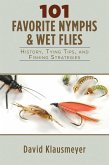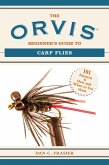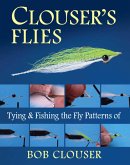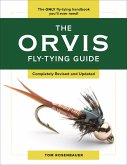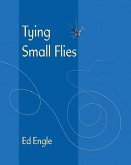Vince Wilcox's Naturally Artificial Signature Flies (eBook, ePUB)
Learn To Tie The Best-Selling, Most Effective Patterns


Alle Infos zum eBook verschenken

Vince Wilcox's Naturally Artificial Signature Flies (eBook, ePUB)
Learn To Tie The Best-Selling, Most Effective Patterns
- Format: ePub
- Merkliste
- Auf die Merkliste
- Bewerten Bewerten
- Teilen
- Produkt teilen
- Produkterinnerung
- Produkterinnerung

Hier können Sie sich einloggen

Bitte loggen Sie sich zunächst in Ihr Kundenkonto ein oder registrieren Sie sich bei bücher.de, um das eBook-Abo tolino select nutzen zu können.
Vince Wilcox's Naturally Artificial Signature Flies will enable tiers of all levelsfrom absolute beginners to long time tying expertsto follow along with ease. Vince Wilcox's Naturally Artificial Signature Flies has detailed, color images of all the steps. Some of the flies will feature over fifty photos in order to clearly illustrate for the beginner how to complete the fly patterns. The expert tier will find a plethora of useful tips and techniques throughout. Featured flies will cover all fishing situations from nymphs, dry flies, and terrestrials, and discuss the thought processes behind…mehr
- Geräte: eReader
- mit Kopierschutz
- eBook Hilfe
- Größe: 33.97MB
- FamilySharing(5)
![101 Favorite Nymphs and Wet Flies (eBook, ePUB) 101 Favorite Nymphs and Wet Flies (eBook, ePUB)]() David Klausmeyer101 Favorite Nymphs and Wet Flies (eBook, ePUB)10,87 €
David Klausmeyer101 Favorite Nymphs and Wet Flies (eBook, ePUB)10,87 €![Hunting Musky with a Fly (eBook, ePUB) Hunting Musky with a Fly (eBook, ePUB)]() Rick KustichHunting Musky with a Fly (eBook, ePUB)29,66 €
Rick KustichHunting Musky with a Fly (eBook, ePUB)29,66 €![The Orvis Beginner's Guide to Carp Flies (eBook, ePUB) The Orvis Beginner's Guide to Carp Flies (eBook, ePUB)]() Dan C. FrasierThe Orvis Beginner's Guide to Carp Flies (eBook, ePUB)8,89 €
Dan C. FrasierThe Orvis Beginner's Guide to Carp Flies (eBook, ePUB)8,89 €![Clouser's Flies (eBook, ePUB) Clouser's Flies (eBook, ePUB)]() Bob ClouserClouser's Flies (eBook, ePUB)18,78 €
Bob ClouserClouser's Flies (eBook, ePUB)18,78 €![The Orvis Fly-Tying Guide (eBook, ePUB) The Orvis Fly-Tying Guide (eBook, ePUB)]() Tom RosenbauerThe Orvis Fly-Tying Guide (eBook, ePUB)30,65 €
Tom RosenbauerThe Orvis Fly-Tying Guide (eBook, ePUB)30,65 €![Smallmouth Bass Flies Top to Bottom (eBook, ePUB) Smallmouth Bass Flies Top to Bottom (eBook, ePUB)]() Jake VillwockSmallmouth Bass Flies Top to Bottom (eBook, ePUB)26,69 €
Jake VillwockSmallmouth Bass Flies Top to Bottom (eBook, ePUB)26,69 €![Tying Small Flies (eBook, ePUB) Tying Small Flies (eBook, ePUB)]() Ed EngleTying Small Flies (eBook, ePUB)22,74 €
Ed EngleTying Small Flies (eBook, ePUB)22,74 €-
-
-
Dieser Download kann aus rechtlichen Gründen nur mit Rechnungsadresse in A, B, BG, CY, CZ, D, DK, EW, E, FIN, F, GR, HR, H, I, LT, L, LR, M, NL, PL, P, R, S, SLO, SK ausgeliefert werden.
- Produktdetails
- Verlag: Simon + Schuster LLC
- Seitenzahl: 264
- Erscheinungstermin: 3. April 2012
- Englisch
- ISBN-13: 9781461746263
- Artikelnr.: 42712984
- Verlag: Simon + Schuster LLC
- Seitenzahl: 264
- Erscheinungstermin: 3. April 2012
- Englisch
- ISBN-13: 9781461746263
- Artikelnr.: 42712984
- Herstellerkennzeichnung Die Herstellerinformationen sind derzeit nicht verfügbar.
A brief synopsis of what the reader can expect to accomplish by purchasing
“Synthetic Synergism”, including why tiers of all levels and all regions
can benefit from it.
Part I
Nymphs
Chapter One
Minute midge – A midge pattern created to be fast, efficient and of course
productive. Basic rotary vise skills will be applied and lead into more
complicated patterns.
Chapter Two
Lint Bug – A fly that has been the favorite of many anglers throughout the
country. Learn how to tie the fly that started as a pocket lint request.
Chapter Three
Marabare – The Marabare is a guide fly, meaning it can be quickly tied and
fished in a variety of situations. Combines the techniques and materials
used in the minute midge and lint bug even while adding another level of
sophistication by incorporating a trailing shuck. The new tungsten anodized
beads give it a fresh look and a quicker descent.
Chapter Four
VW Emerger – This fly combines synthetics to create a midge/baetis that has
been sold by the thousands.
Chapter Five
Madison pupa – Named after my daughter and the river, this fly will
incorporate the use of eyes for additional weight and allow tiers to add a
new technique to their belt.
Chapter Six
C-Squared – The cased caddis can be viewed as a free-living caddis from the
bottom or a caddis still in its case from the top, allowing it to cover
several species at once. Another technique is implemented here with the
addition of collars and full wing cases.
Chapter Seven
T.N.T. – Caddis pupa are an important part of any tiers arsenal and this
one has been a staple in fly boxes for decades. This “dynamite” fly can
flat-out get it done under the most difficult conditions by fishing it deep
along the bottom or just under the surface and anywhere in between.
Chapter Eight
Ginger Snap – Created to represent the sulphurs of the east and the PMDs of
the west, the addition of a dry fly hackle on a nymph makes the collar
remain stiff under water, producing a trail of tiny air bubble as it makes
its way through the water. Teaching tiers how to create flies with
alternative materials and think outside the bubble.
Chapter Nine
Little Green Machine – This fly has gained a place in fly boxes from coast
to coast by producing in all situations, from still water to rivers and
streams. More underlayment techniques are demonstrated to the tier to show
the translucent properties of the micro tubing.
Chapter Ten
Big Thompson Special – A solid pattern that can be fished for caddis,
stoneflies, and mayflies alike. This pattern is a quick version of the
infamous Copper John that takes one quarter of the time to tie and remains
just as effective.
Chapter Eleven
Microstone – If I could only carry one stone fly, this is the one. The
first of its kind to incorporate midge tubing for an abdomen, throw on a
wire rib and a wing case coated with UV knot sense and you have a stone fly
designed to ride upside down to avoid snagging and more positive hook sets.
Chapter Twelve
Rapunzel – A true damsel in distress, this fly has been able to come to the
rescue for anglers around the world. Damsels are abundant in every lake and
stream and can also be fished as a Hexagenia or dragon nymph in the larger
sizes. A unique design that utilizes nymph tubing burned into a set of
glass eyes to hold them in place using a cautery tool and an underlayment
beneath the tubing for an added touch of realism all while swimming through
the water with its Cul De Chicken tail and wing pads.
Chapter Thirteen
3WB – Wilcox’s Woven Water Boatman teaches tiers several different
techniques, including how to use a half-hitch weave to create a lateral
profile made of midge diamond braid, and a full flash wing case covered in
knot sense to represent the air bubble the naturals carry on their belly.
Another fly designed to ride upside down and engage the fish in a more
positive manner while avoiding streambed vegetation.
Chapter Fourteen
Prince Charming – Prince charming is the perfect blend of natural and
synthetic materials, creating a synergistic effect that makes it a shop
favorite. Here we will discuss the benefits of adding the tungsten head and
dry fly hackle collar as well the history behind the original Prince Nymph.
Chapter Fifteen
Superman – There is an added element of fun to your fishing when you are
asked, “What did you get ‘em on?” and you can respond, “Superman.” We
discuss wire abdomens and the first ever commercial fly to use knotted
micro tubing for legs.
Chapter Sixteen
Bunny Bugger – Utilizing the newest materials and some new techniques, this
bugger works for trout, bass, northern pike, salmon and steelhead.
Part II
Dries
Chapter Seventeen
Para-Variant – The first parachute fly of the book is tied using new and
easy to follow techniques. This was also the first dry fly I tie having
replaced the traditional quill bodies with the synthetic tubing to aide in
flotation and durability.
Chapter Eighteen
ELC – Many anglers believe what they are witnessing in the evening is a
caddis “hatch” when in fact it is the pregnant females returning to the
water to drop their eggs. We discuss what to look for and the alternative
ways to tie and fish this pattern.
Chapter Nineteen
Bevo – This caddis utilizes stripped grizzly hackle quills to represent
long antennae. Add trimmed foam for wing pads to supply extra buoyancy and
stability.
Chapter Twenty
Low Rider – This little CDC parachute mayfly has been a favorite of spring
creek and tail water fisherman because of its realistic profile and
addition of the high vis parachute.
Chapter Twenty-One
AC Caddis – Elk hair is used as a parachute as well as antennae,
demonstrating to the tier how to make the wing, parachute, and antennae
from one material.
Chapter Twenty-Two
Micro Midge – The first of its kind in production, this extended-body tube
midge is easy to tie and flat out catch fish, especially during those
hatches when the angler needs to drop down to fifteen feet of leader and a
7X tippet.
Chapter Twenty-Three
Micro Mayfly – Another first in the industry, this fly utilizes tubing as
well as micro fibbets to form the tail. Add a realistic set of microscopic
eyes by incorporating a cautery tool and some nymph tubing for a realistic
wing. This mayfly has outstanding visibility for those anglers looking to
see a size twenty from sixty feet away.
Chapter Twenty-Four
JC Special – This fly was created to help my long-time fishing partner
John Clark see the fly better on the water. The addition of rubber legs
makes the fly come alive. Hundreds of thousands of this fly have been sold,
and the tying steps have never been released.
Chapter Twenty-Five
Dingle Berry – Articulated nymphs and streamers have been around for some
time, but articulated dries were unavailable on the commercial market until
I created this series.
Chapter Twenty-Six
Foam Sally – One of the first commercially-available flies to incorporate
foam for a wing, and the first to use adhesive foams to add a mottled wing
to the underside, this pattern floats like a cork even while riding in the
film just as a natural would.
Part III
Terrestrials
Chapter Twenty-Seven
Glo-Ant – Incorporating the use of a phosphate-impregnated yarn to add a
glow-in-the-dark wing is a first in the industry. Tied in larger sizes,
these flies can make nighttime fishing a reality for many anglers, and in
the sunlight the glowing sheen gives the wing a realistic appearance on the
water. All species of fish have found this one hard to resist.
Chapter Twenty-Eight
Herbie –Created as a cicada pattern, this beetle imitation can also be
fished as a cricket with outstanding results. The No-Fray wing over the top
of the foam is impossible for fish to resist and it floats like a cork too.
Chapter Twenty-Nine
VW Hopper – Sold by the thousands, these hoppers have taken the angling
world by storm, and for good reason. The foam overlays used on this fly
were the first of their kind, and the addition of a set of eyes make this
fly too hard to resist for the angler and the fish.
Chapter Thirty
Nymphing strategies for rivers and still waters – This final section will
give anglers the benefit of my thirty years of experience, providing
techniques to make them more successful anglers in all situations, complete
with diagrams.
A brief synopsis of what the reader can expect to accomplish by purchasing
“Synthetic Synergism”, including why tiers of all levels and all regions
can benefit from it.
Part I
Nymphs
Chapter One
Minute midge – A midge pattern created to be fast, efficient and of course
productive. Basic rotary vise skills will be applied and lead into more
complicated patterns.
Chapter Two
Lint Bug – A fly that has been the favorite of many anglers throughout the
country. Learn how to tie the fly that started as a pocket lint request.
Chapter Three
Marabare – The Marabare is a guide fly, meaning it can be quickly tied and
fished in a variety of situations. Combines the techniques and materials
used in the minute midge and lint bug even while adding another level of
sophistication by incorporating a trailing shuck. The new tungsten anodized
beads give it a fresh look and a quicker descent.
Chapter Four
VW Emerger – This fly combines synthetics to create a midge/baetis that has
been sold by the thousands.
Chapter Five
Madison pupa – Named after my daughter and the river, this fly will
incorporate the use of eyes for additional weight and allow tiers to add a
new technique to their belt.
Chapter Six
C-Squared – The cased caddis can be viewed as a free-living caddis from the
bottom or a caddis still in its case from the top, allowing it to cover
several species at once. Another technique is implemented here with the
addition of collars and full wing cases.
Chapter Seven
T.N.T. – Caddis pupa are an important part of any tiers arsenal and this
one has been a staple in fly boxes for decades. This “dynamite” fly can
flat-out get it done under the most difficult conditions by fishing it deep
along the bottom or just under the surface and anywhere in between.
Chapter Eight
Ginger Snap – Created to represent the sulphurs of the east and the PMDs of
the west, the addition of a dry fly hackle on a nymph makes the collar
remain stiff under water, producing a trail of tiny air bubble as it makes
its way through the water. Teaching tiers how to create flies with
alternative materials and think outside the bubble.
Chapter Nine
Little Green Machine – This fly has gained a place in fly boxes from coast
to coast by producing in all situations, from still water to rivers and
streams. More underlayment techniques are demonstrated to the tier to show
the translucent properties of the micro tubing.
Chapter Ten
Big Thompson Special – A solid pattern that can be fished for caddis,
stoneflies, and mayflies alike. This pattern is a quick version of the
infamous Copper John that takes one quarter of the time to tie and remains
just as effective.
Chapter Eleven
Microstone – If I could only carry one stone fly, this is the one. The
first of its kind to incorporate midge tubing for an abdomen, throw on a
wire rib and a wing case coated with UV knot sense and you have a stone fly
designed to ride upside down to avoid snagging and more positive hook sets.
Chapter Twelve
Rapunzel – A true damsel in distress, this fly has been able to come to the
rescue for anglers around the world. Damsels are abundant in every lake and
stream and can also be fished as a Hexagenia or dragon nymph in the larger
sizes. A unique design that utilizes nymph tubing burned into a set of
glass eyes to hold them in place using a cautery tool and an underlayment
beneath the tubing for an added touch of realism all while swimming through
the water with its Cul De Chicken tail and wing pads.
Chapter Thirteen
3WB – Wilcox’s Woven Water Boatman teaches tiers several different
techniques, including how to use a half-hitch weave to create a lateral
profile made of midge diamond braid, and a full flash wing case covered in
knot sense to represent the air bubble the naturals carry on their belly.
Another fly designed to ride upside down and engage the fish in a more
positive manner while avoiding streambed vegetation.
Chapter Fourteen
Prince Charming – Prince charming is the perfect blend of natural and
synthetic materials, creating a synergistic effect that makes it a shop
favorite. Here we will discuss the benefits of adding the tungsten head and
dry fly hackle collar as well the history behind the original Prince Nymph.
Chapter Fifteen
Superman – There is an added element of fun to your fishing when you are
asked, “What did you get ‘em on?” and you can respond, “Superman.” We
discuss wire abdomens and the first ever commercial fly to use knotted
micro tubing for legs.
Chapter Sixteen
Bunny Bugger – Utilizing the newest materials and some new techniques, this
bugger works for trout, bass, northern pike, salmon and steelhead.
Part II
Dries
Chapter Seventeen
Para-Variant – The first parachute fly of the book is tied using new and
easy to follow techniques. This was also the first dry fly I tie having
replaced the traditional quill bodies with the synthetic tubing to aide in
flotation and durability.
Chapter Eighteen
ELC – Many anglers believe what they are witnessing in the evening is a
caddis “hatch” when in fact it is the pregnant females returning to the
water to drop their eggs. We discuss what to look for and the alternative
ways to tie and fish this pattern.
Chapter Nineteen
Bevo – This caddis utilizes stripped grizzly hackle quills to represent
long antennae. Add trimmed foam for wing pads to supply extra buoyancy and
stability.
Chapter Twenty
Low Rider – This little CDC parachute mayfly has been a favorite of spring
creek and tail water fisherman because of its realistic profile and
addition of the high vis parachute.
Chapter Twenty-One
AC Caddis – Elk hair is used as a parachute as well as antennae,
demonstrating to the tier how to make the wing, parachute, and antennae
from one material.
Chapter Twenty-Two
Micro Midge – The first of its kind in production, this extended-body tube
midge is easy to tie and flat out catch fish, especially during those
hatches when the angler needs to drop down to fifteen feet of leader and a
7X tippet.
Chapter Twenty-Three
Micro Mayfly – Another first in the industry, this fly utilizes tubing as
well as micro fibbets to form the tail. Add a realistic set of microscopic
eyes by incorporating a cautery tool and some nymph tubing for a realistic
wing. This mayfly has outstanding visibility for those anglers looking to
see a size twenty from sixty feet away.
Chapter Twenty-Four
JC Special – This fly was created to help my long-time fishing partner
John Clark see the fly better on the water. The addition of rubber legs
makes the fly come alive. Hundreds of thousands of this fly have been sold,
and the tying steps have never been released.
Chapter Twenty-Five
Dingle Berry – Articulated nymphs and streamers have been around for some
time, but articulated dries were unavailable on the commercial market until
I created this series.
Chapter Twenty-Six
Foam Sally – One of the first commercially-available flies to incorporate
foam for a wing, and the first to use adhesive foams to add a mottled wing
to the underside, this pattern floats like a cork even while riding in the
film just as a natural would.
Part III
Terrestrials
Chapter Twenty-Seven
Glo-Ant – Incorporating the use of a phosphate-impregnated yarn to add a
glow-in-the-dark wing is a first in the industry. Tied in larger sizes,
these flies can make nighttime fishing a reality for many anglers, and in
the sunlight the glowing sheen gives the wing a realistic appearance on the
water. All species of fish have found this one hard to resist.
Chapter Twenty-Eight
Herbie –Created as a cicada pattern, this beetle imitation can also be
fished as a cricket with outstanding results. The No-Fray wing over the top
of the foam is impossible for fish to resist and it floats like a cork too.
Chapter Twenty-Nine
VW Hopper – Sold by the thousands, these hoppers have taken the angling
world by storm, and for good reason. The foam overlays used on this fly
were the first of their kind, and the addition of a set of eyes make this
fly too hard to resist for the angler and the fish.
Chapter Thirty
Nymphing strategies for rivers and still waters – This final section will
give anglers the benefit of my thirty years of experience, providing
techniques to make them more successful anglers in all situations, complete
with diagrams.

